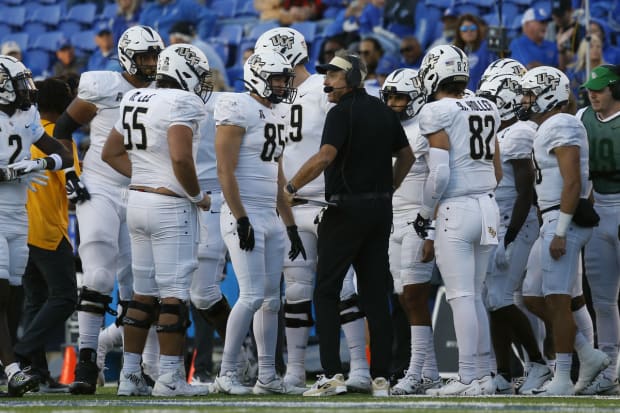On the rooftop of a swanky hotel on the West Side of Manhattan, it’s clear things are about to change for UCF. A spirited group of alumni gathered to meet with coaches of the football and men’s and women’s basketball teams, and AD Terry Mohajir. The Knights are just about to finish their life cycle in the American Athletic conference and start anew in the Big 12. It’s fitting that they’ve taken their show on the road in the city commissioner Brett Yormark calls home.
The final conference matchup against rival USF will come this weekend at the AAC baseball tournament. UCF’s movement has been noticed across its home state as well: In Tallahassee earlier this month, as Florida State saber-rattled over revenue concerns, FSU AD Michael Alford said the fact that UCF will soon draw more revenue than his own school (and Miami) will in their conference media agreement is “not acceptable.”
The Knights are certainly moving up quickly in the college sports world, continuing to draft off their success on the field, like the 2017 claimed national championship in which they capped the year off by beating their current coach, Gus Malzahn, at his former school, Auburn. On the field in the Big 12, Malzahn knows that things are going to be different, especially with road games at Kansas State, Kansas, Oklahoma, West Virginia and Cincinnati, plus a nonconference date with Boise State.
“You have to be deep on the offense and defensive lines,” Malzahn said. “We’ll see about how much quality depth we have. But we do have depth right now. But when you move up leagues or whatever levels, it’s about upfront for the most part, have enough depth to withstand the whole season.”
Watch college football with fuboTV. Start your free trial today.

Petre Thomas/USA TODAY Sports
Malzahn said that the new league will help with recruiting, too; ever since he’s been in Orlando, UCF has lost out on players who simply want to play in a Power 5 league. In Malzahn’s first year, UCF beat Florida in a bowl game, going 9–4, and in his second, it made the conference championship game and went 9–5. It will be a geographical outpost in the new league, with the closest conference opponent being a 13-hour drive, and most of the league based in Texas. The Knights plan to use their location as a strength.
“We have some guys on [our coaching] staff that are from Texas,” Malzahn said. “But primarily, we don’t need to leave the state of Florida and Georgia. We’re hanging our hat on Florida all the way to Atlanta. But if we have a special connection with somebody, like a really good connection in Texas, we’ll recruit. Or Arkansas, which I’m from, and Alabama. But for the most part it’s probably going to be 80% from Florida and Georgia.”
A problem the distance poses is the lack of ties that bind. UCF had a short-lived, vibrant rivalry with USF an hour down the road in Tampa called the “War on I-4.” The two teams will pause their rivalry until at least 2028. The only school with any shred of association is Cincinnati, which, like the Knights, has spent the last few years perennially at the top of the conference.
If UCF’s rise seems quick, that’s because it is. The school’s been around since only 1963 and has been an FBS team since only ’96. There is a massive alumni base, as the school has one of the biggest enrollments in the country (more than 68,000), but that base is young, and it will take time for them to accumulate disposable wealth en masse to donate back. So yes, UCF is new money, but, just like the shiny new skyscrapers in Manhattan’s Hudson Yards development a few blocks up the street, they do look the part.







